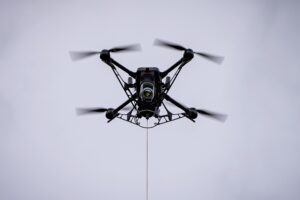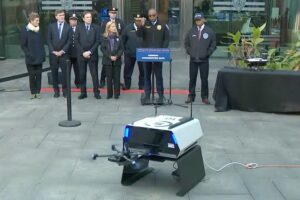When it comes to choosing between the DJI Air 3S vs. DJI Mini 4 Pro, you’re not just picking a drone—you’re deciding what kind of pilot you want to be. Both of these DJI camera drones pack impressive features, but they cater to different audiences. The DJI Air 3S excels in raw power and versatility. Meanwhile the DJI Mini 4 Pro offers portability and simplicity without sacrificing too much performance.
The DJI Air 3S is my favorite overall drone for travelers. But the DJI Mini 4 Pro might still be better for some types of travelers. It weighs less than 250 grams, meaning recreational pilots in the U.S. don’t need to register it with the Federal Aviation Administration. That also just means it’s more portable for ultra-light packers. Plus, it’s slightly cheaper, starting at $759 for the DJI Mini 4 Pro vs. $1,099 for the DJI Air 3S.
So which should you choose between the DJI Air 3S vs. DJI Mini 4 Pro? Here’s how to decide:
DJI Air 3S vs. DJI Mini 4 Pro: which drone is better?
- Comparing the DJI Air 3S vs. DJI Mini 4 Pro on key specs
- Flight capabilities: flight time, wind resistance and more
- Size and portability
- Camera quality
- Battery life: who is the real winner here?
- Intelligent Features while flying
- DJI Air 3S vs. DJI Mini 4 Pro: other differences
- DJI Air 3S vs. DJI Mini 4 Pro: which should you buy?
Comparing the DJI Air 3S vs. DJI Mini 4 Pro on key specs
Generally speaking, the DJI Mini 4 Pro is the smaller, lighter and cheaper drone. The DJI Air 3S is bigger and more powerful. Here’s exactly what I mean, by way of a straightforward comparison table:
| Feature | DJI Air 3S | DJI Mini 4 Pro | Winner |
|---|---|---|---|
| Starting Price | $1,099 | $759 | Mini 4 Pro |
| Wind Resistance | Up to 12 m/s (26.8 mph); rock-solid stability | Up to 10.7 m/s (24 mph); solid for its size | DJI Air 3S |
| Weight | 724g | 249g | Mini 4 Pro |
| Dimensions (folded, without propellers) | 214.19×100.63×89.17 mm | 148×94×64 mm | Mini 4 Pro |
| Camera | Dual camera: 1-inch CMOS wide-angle 1/1.3-inch (medium tele) |
Single 1/1.3-inch sensor, HDR | DJI Air 3S |
| Internal Storage | 42 GB | 2 GB | DJI Air 3S |
| Battery Life | Up to 45 minutes | Up to 45 minutes with Intelligent Flight Battery Plus, otherwise 34 minutes | DJI Air 3S |
| Portability | Compact but heavier; requires registration | Ultra-light, no registration required (<250g) | Mini 4 Pro |
| Obstacle Sensing | Omnidirectional, supplemented with forward-facing LiDAR | Omnidirectional | DJI Air 3S |
| Video Transmission | O4 | O4 | Tie |
Let me break down what all those specs actually mean:
Flight capabilities: flight time, wind resistance and more

I call the DJI Air 3S my favorite drone for travel photographers for a reason: it holds up pretty well in bad weather conditions. When you’re traveling, you often don’t have a choice when you can fly. If it’s windy out but you’re traveling, you likely don’t have the luxury of “just coming back tomorrow.”
If you can’t wait for something like wind to die down, then the DJI Air 3S is your better bet. Built for stability, the Air 3S handles winds up to 12 m/s (26.8 mph) with ease. Plus, an alert in the controller makes it clear if you’re flying in too strong of winds so you can quickly get to safety.
That happened to me exactly when I took my Air 3S on a trip to Oahu. I was only in each town for a day (well, often just an hour) and wanted specific shots. I flew in conditions that I wouldn’t dare put my Mini 4 Pro in. Check out the aggressive palm tree swaying in the wind in that photo above. Meanwhile, the Air 3S held steady.
Still though, don’t expect to fly the Air 3S in a full storm. Keep it clear of rain, and avoid heavy winds.
But with the DJI Mini 4 Pro, you even have to keep it clear of strong breezes. Sure, the Mini 4 Pro has good wind resistance of 10.7 m/s (24 mph). That’s pretty exceptional for a sub-250g drone. However, its lightweight frame can be pushed around in particularly turbulent conditions. While it’s better than its predecessors, I’d hesitate to fly it in strong winds.
Winner: The DJI Air 3S reigns supreme for windy conditions, but the Mini 4 Pro is no slouch for its size.
- Order the DJI Air 3S drone from Amazon, starting at $1,099.
- Order the DJI Air 3S drone from B&H Photo, starting at $1,099.
- Order the DJI Air 3S drone from Drone Nerds, starting at $1,099.
Size and portability
The power in the wind has to do largely with the Air 3S’s bigger, heavier frame that can anchor it against gusts. But for travelers who want the smallest, lightest gear, that’s a drawback relative to the DJI Mini 4 Pro. At just 249g, the Mini 4 Pro is ultra-portable. In fact, I could fit it into a larger jacket pocket (like a snow jacket).
For what it’s worth, the DJI Air 3S is certainly compact and foldable relative to something like a Phantom or Inspire. Also note that the Air 3S’s 724g weight means it requires registration in most countries (including the U.S.), adding a bit of hassle.
Winner: The Mini 4 Pro is the ultimate choice for portability and convenience.
Camera quality
The Air 3S’s dual camera system (wide and telephoto) is a step above the rest, allowing you to either frame vast landscapes or zoom in on details. There’s a 1-inch CMOS wide-angle, plus a 1/1.3-inch (medium tele). It captures 4K/60fps video, HDR, and 10-bit color, and its D-Log capabilities shine for professional-grade editing. Whether you’re framing a vast landscape or zooming in on details, the Air 3S delivers.
Here are some sample shots I filmed in Oahu to give you a sense of the image quality on the DJI Air 3S:
The DJI Mini 4 Pro is, well, simpler. It has a single 1/1.3-inch sensor that supports 4K/60fps and HDR. That’s good, but it’s just so hard to compete with the DJI Air 3S. Sure, the video quality is comparable to the Air 3S in good conditions, but it lacks a telephoto lens and advanced color profiles like D-Log. That might be limiting for creatives and professionals.
Winner: The DJI Air 3S takes the crown for advanced camera features. For what it’s worth, the Mini 4 Pro holds its own for casual or semi-professional use.
Battery life: who is the real winner here?

The DJI Air 3S offers up to 45 minutes of flight time. That’s impressive against all competitors, period.
Now the DJI Mini 4 Pro also offers 45 minutes, kind of. The primary battery gets you just 34 minutes of flight time, which is still pretty good. To get 45 minutes, you have to upgrade to the “Intelligent Flight Battery Plus,” which entails an extra cost. This battery is also heavier (which puts you over the 249 gram threshold).
The “Plus” battery for the Pro retails for $95 when purchased a la carte, so factor that into your decision if price is important to you. Or, you can buy a DJI Mini 4 Pro Fly More Combo Plus with DJI RC 2, which costs $1,159 and includes the Mini 4 Pro drone, a DJI RC 2 Remote Controller, three Intelligent Flight Battery Plus, and a few other accessories. That’s a better deal than purchasing everything a la carte (though three batteries might be overkill).
Winner: Tie
Related read: DJI Air 3 vs. DJI Air 3S: is it worth the upgrade?
Intelligent Features while flying
Both of these drones offer omnidirectional obstacle sensing, which allows the drone to see objects in front, behind and on sides. And when it does, rather than keep on flying, it’ll simply hover in front (or navigating intelligently around, depending on the flight mode). It’s impressive, and classifies it as somewhat crashproof.
Both drones have automatic flight modes that allow it to fly pre-programmed paths. With the DJI Mini 4 Pro, comes intelligent flight modes such as:
- MasterShots: Delivers dynamic camera movement templates tailored for portrait, close-up, and long-range shots, ensuring you nail every shot
- QuickShots: Provides Dronie, Circle, Helix, Rocket, Boomerang, and Asteroid moves for more style results
- Hyperlapse: Provides Free, Waypoint, Circle, and Course Lock modes with unlimited shooting time and supports compositing while shooting
- Panorama: Supports shooting 180, Wide Angle, Vertical, and Sphere panoramic photos to capture landscapes
But the DJI Air 3S turns it up further with waypoint missions and Free Panorama mode. As far as obstacle sensing, it’s a smarter version of it thanks to forward-facing LiDAR technology, which is particularly useful if flying in low light.
The Air 3S also has a Next-Gen Smart RTH (Return-to-Home). It uses real-time vision positioning and map construction technologies to memorize flight paths, which is useful if you took off without connecting to satellite signals (which is sometimes inevitable when launching from certain locations, such as balconies).
Watch the Air 3S execute a flight returning to home automatically at 2:44 in this clip:
Winner: The Air 3S edges out for its slightly smarter features.
DJI Air 3S vs. DJI Mini 4 Pro: other differences
Those are the big differences, but the DJI Air 3S has made some tweaks from the DJI Mini 4 Pro that don’t get talked about enough in the main points, but do make a real difference.
Built-in storage: I am loving the 42 GB of internal storage on the DJI Air 3S vs. just 2 GB on the DJI Mini 4 Pro. 2 GB is great if you’re in a pinch and, maybe, forgot your microSD card. 42 GB makes it so you don’t even need a microSD card. Less stuff is a win all around.
More space efficient: No, not that kind of space, as the Air 3S is certainly bigger. I’m talking about digital space. The Air 3S employs a more advanced video encoding compression algorithm that reduces video file sizes by over 30%. Yes, that’s without compromising image quality.
DJI Air 3S vs. DJI Mini 4 Pro: which should you buy?
If you’re someone who likes traveling with your drone, either the DJI Air 3S vs. DJI Mini 4 Pro are an excellent bet.
- The DJI Air 3S is best for you if… you’re a professional or enthusiast who prioritizes stability, advanced camera features, and creative control in challenging conditions. You don’t mind a larger size in favor of a more powerful drone. Check out my full DJI Air 3S review.
- The DJI Mini 4 Pro is best for you if… you value either size or price. For travelers or casual pilots seeking a lightweight, easy-to-use drone with excellent performance for its size. It’s not as powerful, but it’s neither as large nor as pricey. Check out my full DJI Mini 4 Pro review.
Are you looking for a professional-grade powerhouse (DJI Air 3S)?
- Order the DJI Air 3S drone from Amazon, starting at $1,099.
- Order the DJI Air 3S drone from B&H Photo, starting at $1,099.
- Order the DJI Air 3S drone from Drone Nerds, starting at $1,099.
Would you prefer an ultraportable companion (DJI Mini 4 Pro) for your next adventure?
Either way, DJI has you covered.
The post DJI Air 3S vs. DJI Mini 4 Pro: how to choose the best drone for you appeared first on The Drone Girl.







